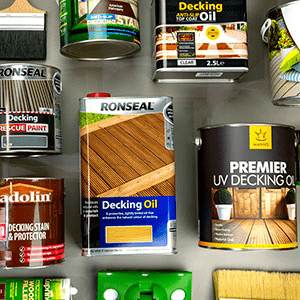Fence Treatment FAQ's
What is the best fence paint?
Garden paints that are suitable for garden fences come in a wide range of colours and formulations. All are designed to colour and protect garden fences from weathering. Two popular products we offer are Cuprinol Garden Shades Paint and Ronseal Garden Paint, both of which are ideal for wooden fence panels and posts.
It's worth noting that there are a wide range of wood preservatives and exterior wood oils that also colour and protect garden wood and can also be used on wooden fence panels and posts. See our full range of garden fence treatments here.
Does it matter if my fence panels are rough sawn or smooth?
In terms of the amount of fence treatment required, yes it does. This is because rough sawn woods are very porous and absorb more treatment than smooth planed wood. This should be taken into consideration if treating a large area of garden fencing. Our Barrettine Premier Wood Preservative page has colour swatches that show the potential colour difference between rough and smooth wood. This illustration should only be used as a guide and not as a substitute for doing a test area.
Because rough sawn fence panels absorb more wood finishing product than smooth planed wood, any colour pigment in the product is likely to look stronger or darker than it would on a smooth piece of timber. Always do a test area to be sure of the colour and final finish before starting any project. It's also worth noting that although wood finish colours may initially look stronger than expected when applied, they usually 'tone-down' after several weeks or months of weathering.
Do I have to use a 'shed and fence' specific wood preservative?
Most wood preservatives are similar in what they do even if specific formulations can differ slightly. Using a general purpose exterior wood preservative such as Barrettine Premier Wood Preservative or Ronseal Total Wood Preservative is absolutely fine.
What sort of wood oil should I use on my garden fence?
Using a wood oil on a garden fence is a great way of prolonging the life of fence panels and posts. Decking oils are perfect for use on fence panels as they help to protect the timber from cracking, splitting and warping. They provide excellent weather resistance and are available in both clear and coloured formulations.
When treating a new fence or a bare wood one that hasn't been treated for a number of years, we highly recommend treating the fence panels with 2 coats of an exterior wood preservative prior to oiling. This helps to protect the timber from biological threats such as mould, algae and wood boring insects.
How can I clean green algae from wooden fence panels?
Green algae can usually be cleaned from fence panels by first brushing with a stiff brush or broom to remove as much of the surface growth as possible, then treating with a mould and mildew cleaner such as Barrettine Mould and Mildew Cleaner. Fence panels that have been become heavily soiled with biological growth may require a second treatment.
Once cleaned, treated and allowed to dry, fence panels should then be treated with a wood preservative, this will help to prevent future growth of mould and algae.
How much garden fence treatment do I need
The amount of garden fence treatment needed for a given project can vary and is dependent on the type of product being used, the area of wooden fence to be treated and to a degree, the type and the condition of the wood. For this reason, each of the product pages on our site have a handy 'coverage calculator'. Simply calculate the area to be covered, in either feet or meters and our coverage calculator will give you an estimate of how many litres of fence treatment are required. It's worth remembering that the figure given is an estimate as factors such as the porosity of wood, condition and application method can all have an influence on the coverage of a product. That said it's rare we hear from customers saying the amount of product ordered was not enough.
I have replaced some garden fencing and the panels are pressure treated and have a light green/tan appearance. The other panels are Harvest Brown as they have been previously treated with Cuprinol One Coat Sprayable Fence Treatment. The new panels are obviously "odd" and I am planning to treat all the panels to make them look the same. I have just purchased several 5L containers of the Cuprinol product to re-treat the existing panels but wondered if the newer (installed in the last week) panels will be okay to treat as I have heard the product will just run off after application.
It is perfectly fine to treat new fence panels that have been tanalised or pressure treated, the finish will not run off.
Matching the colour of old and new fence panels can be difficult and its unlikely that they will look exactly the same. This said however, it may be possible to get them looking similar over time.
It's important to remember that any coloured fence treatment can look 'bright' when first applied but will tone down after several weeks or months of weathering. One possible approach could be to treat the older panels with just one coat of treatment but apply 2 coats to the newer panels. This will give a darker, stronger colour to the new which should tone down to better match the older panels after a couple of weeks or months. After this time you will be able to assess weather to leave as they are, re-coat just the new panels again or re treat the whole fence to achieve a better colour match. The newer panels will naturally start to blend in with the older as more years pass and they are re-treated.
Before starting this project we strongly recommend that test patches are done on the new and old panels to access the success of the above.
Hi, I'm about to erect a new fence which has been pressure treated and was wandering if Osmo clear extra would be suitable. The timber is redwood smooth planed.
The Osmo UV Protection Oil Extra is a good option to consider for a smooth planed fence. The UV Protection Oil Extra will slow down the silvering of the wood caused by weathering and UV damage. Being an oil as apposed to a paint or varnish. It will not peel or flake over time.
An alternative approach would be to use a Decking Oil. Decking oils are very versatile and can be used for a wide range of exterior wood care projects project. Barrettine Decking Oil also contains UV filters to slow down the natural silvering process and is also available in a clear finish.
Is Cuprinol Ultimate recommended to use on new pressure treated fence panelling . If so how long before I can treat my fence.
Cuprinol Ultimate Garden Wood Preserver is an ideal product for your fence. It will help to prevent mould and rot and contains wax to repel moisture, which is the biggest cause of damage to wood.
Because this product is coloured it will also provide some protection against UV damage.
Can you recommend a fence paint for a softwood, rough sawn, timber fence?
Picking the right fence paint for your project can come down to a number of factors, but more often than not, the main deciding factors are colour and cost.
We stock a range of fence paints from Cuprinol, Ronseal and more, all of which will colour and protect garden fences from weathering and the damaging effects of wind, rain and sun. If you are not sure which fence paint is best for your project, call our inhouse experts who are always on hand to answer any questions you may have.
What is the best way of achieving a solid black garden fence finish?
Black fence finishes have become more popular as they provide a striking contrast against the green of grass, trees and other garden plants. Read more about achieving the perfect black wood finish in our blog.
Garden Fence Treatments
Garden Fence related blog posts
- How To Preserve a Fence Panel So it Will Last! - Ronseal Total Wood Preserver.
- How To Work Out Area of Sheds & Fences
- All About Fence Paint - And How to Create Something Special
- All About Wooden Garden Fence Maintenance
Disclaimer: Whilst every attempt has been made to provide product information that is as accurate as possible, it's important to clarify that trees and the wood that they produce can be affected by many factors. For example, the same species of tree grown in the same wood, even in close proximity, will be affected by age along with the amount of sunlight and water they receive. Other naturally occurring biological and environmental factors will also influence the density and grain of the wood as well as the moisture and oil content of the timber. No two trees are the same, meaning each piece of wood has the potential to look and react differently to the same wood finish. For example, product adhesion, colour variations, absorption rates and sheen levels. It is for this reason that we always strongly recommend carrying out test areas before starting any project


